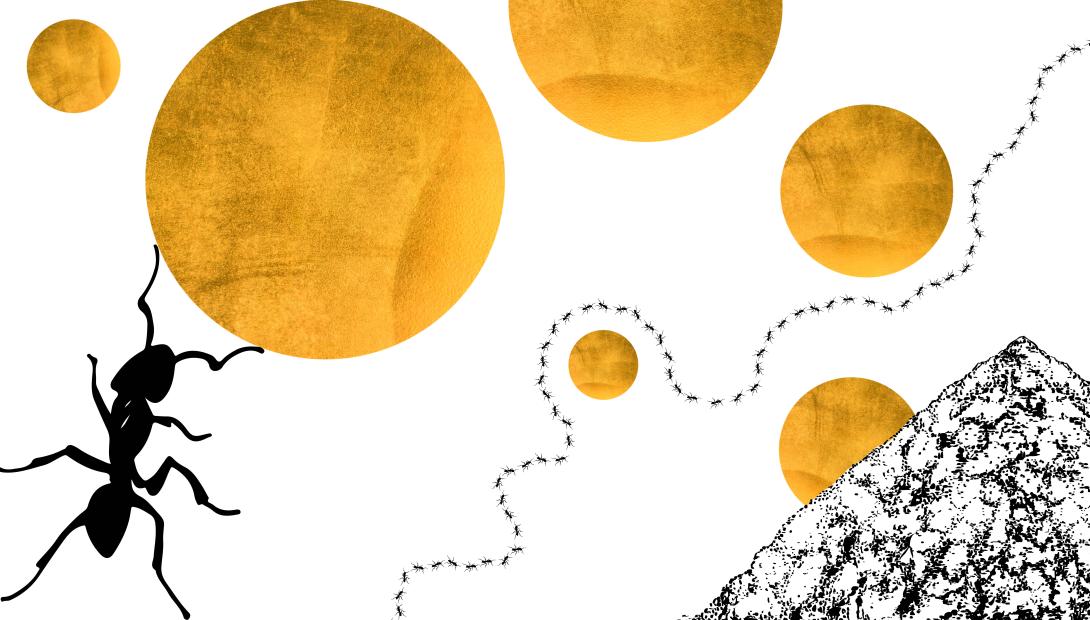
Nests
Every ant family lives in a nest, also called an ant hill. It is a place where one or several queens live and where new generations develop. Nests of the same species that are cooperative and related form a colony.
Types of Nests in Latvia
Mound nest
A small mound of sand that is reinforced by plant roots. The underground passages are not connected to the surface except for during the period of the wedding flight. Ants feed on aphids that are living on the roots of plants.
Soil nest
Structure of vertical chambers and passages excavated in the soil. It must be sunlit for at least part of the day.
Dome shaped nest
The most conspicuous type of nest. It consists of a labyrinth of underground passages and chambers and an above-ground dome made of needles and twigs. This shape allows the efficient accumulation and storage of heat, as well as rainwater drainage. They can be as tall as a man.
Carton nest
A cavity or hollow space in a tree, filled with a cardboard-like material that consists of fungi, soil and shredded wood, glued together with honeydew.
Wood nest
Passage systems in dead or living trees. One colony can inhabit several trees that are connected by underground passages.
Wood nest
In Latvia, such nests are made by species of carpenter ants Camponotus and some species of the genus Lasius.
Carton nest
In Latvia, such nests are made by the Jet Ant Lasius fuliginosus.
Elsewhere in the world
Giant nests
The nests of leafcutter ants are the largest in the world. For some nests, the underground passages extend up to 8 m deep and branch out in an area that exceeds tens of square metres. The largest known number of chambers is 7 864, and their volume can also be impressive – ranging from 25 to 51 litres.
Scientists study the nest of leafcutter ants Atta laevigata in Brazil
Bivouac
Wandering ants do not have a permanent nest. In between their journeys, the worker ants build up a cluster from their bodies around the queen and the initial stages of ant development – bivouac. The bivouac serves as a temporary nest.
Bivouac made by army ants Eciton hamatum in Costa Rica
Mutual communication
Ants mainly use chemicals – pheromones – produced by their glands for communication. Pheromones mark food trails and warn of danger, as well as they are used to identify members of their own family and find mates during the mating season. By combining smell and touch, ants are able to communicate more information to each other than other insects.
Defence
Ants protect their nest and the area around it from competing ants of their own and other species. Fierce fights often occur between ants, resulting in the deaths of multiple ants.
Formic acid
Some species of worker ant produce a chemical called formic acid in their venom glands. It is one of the strongest organic acids. Ants spit formic acid when defending themselves or when hunting.
Seasonal cycle
Ant activity is affected by the ambient temperature. In temperate climates, they are dormant in winter, but active from early spring to late autumn. During this time, queens lay eggs and the new generation develops.
As autumn approaches, the colony begins to prepare for winter. In winter, ants are very inactive and spend this time in the deepest part of their nest.
Robbers
To increase the number of individuals in a colony, some ant species rob their own nest or other species of their pupae, or, less commonly – young ants. The abducted individuals perform the same duties as other worker ants in the new colony.
So-called slave-making ants are involved solely in pillaging nests of other ants and do not take part in the daily work of the colony.
European Amazon Ant Polyergus rufescens.




